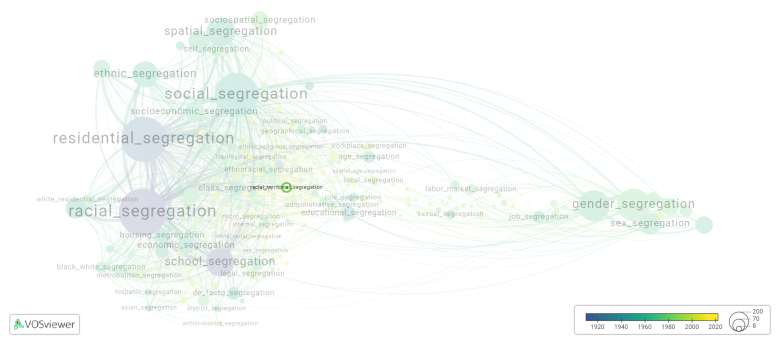Racial territorial segregation: Difference between revisions
(Creating page) |
(Creating page) |
||
| (10 intermediate revisions by the same user not shown) | |||
| Line 1: | Line 1: | ||
===== Date and country of first publication<ref>Date and country of first publication as informed by the Scopus database (December 2023).</ref>===== | |||
1994<br> | 1994<br> | ||
South Africa | |||
===== Definition ===== | |||
Racial territorial segregation refers to the separation of people of different races into geographic areas or neighborhoods based on their racial or ethnic backgrounds. This practice has been historically prevalent in many countries, including the United States during the era of legalized racial segregation known as "Jim Crow" laws. Under these laws, African Americans were often relegated to separate and often inferior neighborhoods. | Racial territorial segregation refers to the separation of people of different races into geographic areas or neighborhoods based on their racial or ethnic backgrounds. This practice has been historically prevalent in many countries, including the United States during the era of legalized racial segregation known as "Jim Crow" laws. Under these laws, African Americans were often relegated to separate and often inferior neighborhoods. | ||
| Line 8: | Line 10: | ||
While racial territorial segregation has decreased in many countries since the civil rights movement, it still persists to some extent in certain regions. Efforts to combat segregation have included fair housing legislation, positive social engineering, and grassroots community organizing. The goal is to create more inclusive and equitable communities that promote diversity and reduce racial disparities. | While racial territorial segregation has decreased in many countries since the civil rights movement, it still persists to some extent in certain regions. Efforts to combat segregation have included fair housing legislation, positive social engineering, and grassroots community organizing. The goal is to create more inclusive and equitable communities that promote diversity and reduce racial disparities. | ||
==See also== | ==See also== | ||
==Related segregation forms== | |||
Racial territorial segregation is frequently discussed in the literature with the following segregation forms: | |||
[[residential segregation]] | |||
[[File:racial_territorial_segregation.png|780x780px]] | |||
This visualization is based on the study [[Segregation_Wiki:About| The Multidisciplinary Landscape of Segregation Research]]. | |||
For the complete network of interrelated segregation forms, please refer to: | |||
* [https://tinyurl.com/2235lkhw First year of publication] | |||
* [https://tinyurl.com/2d8wg5n3 Louvain clusters] | |||
* [https://tinyurl.com/223udk5r Betweenness centrality] | |||
* [https://tinyurl.com/244d8unz Disciplines in which segregation forms first emerged (Scopus database).] | |||
==References== | ==References== | ||
== | ==Notes== | ||
<references /> | |||
{{NoteAI}} | |||
==Racial territorial segregation appears in the following literature== | |||
Taylor B. (1994) | Taylor B. (1994). Local government and ‘coloured’ residential segregation in Port Elizabeth, 1964 1976. ''South African Geographical Journal'', ''76''(1), 20-26. https://doi.org/10.1080/03736245.1994.9713566 | ||
Latest revision as of 07:17, 16 October 2024
Date and country of first publication[1][edit | edit source]
1994
South Africa
Definition[edit | edit source]
Racial territorial segregation refers to the separation of people of different races into geographic areas or neighborhoods based on their racial or ethnic backgrounds. This practice has been historically prevalent in many countries, including the United States during the era of legalized racial segregation known as "Jim Crow" laws. Under these laws, African Americans were often relegated to separate and often inferior neighborhoods.
Racial territorial segregation can result from a variety of factors, including systemic discrimination, socioeconomic disparities, and racial bias. It can have significant impact on the overall quality of life and opportunities available to individuals living in segregated areas.
While racial territorial segregation has decreased in many countries since the civil rights movement, it still persists to some extent in certain regions. Efforts to combat segregation have included fair housing legislation, positive social engineering, and grassroots community organizing. The goal is to create more inclusive and equitable communities that promote diversity and reduce racial disparities.
See also[edit | edit source]
Related segregation forms[edit | edit source]
Racial territorial segregation is frequently discussed in the literature with the following segregation forms:
This visualization is based on the study The Multidisciplinary Landscape of Segregation Research.
For the complete network of interrelated segregation forms, please refer to:
References[edit | edit source]
Notes[edit | edit source]
- ↑ Date and country of first publication as informed by the Scopus database (December 2023).
At its current state, this definition has been generated by a Large Language Model (LLM) so far without review by an independent researcher or a member of the curating team of segregation experts that keep the Segregation Wiki online. While we strive for accuracy, we cannot guarantee its reliability, completeness and timeliness. Please use this content with caution and verify information as needed. Also, feel free to improve on the definition as you see fit, including the use of references and other informational resources. We value your input in enhancing the quality and accuracy of the definitions of segregation forms collectively offered in the Segregation Wiki ©.
Racial territorial segregation appears in the following literature[edit | edit source]
Taylor B. (1994). Local government and ‘coloured’ residential segregation in Port Elizabeth, 1964 1976. South African Geographical Journal, 76(1), 20-26. https://doi.org/10.1080/03736245.1994.9713566

